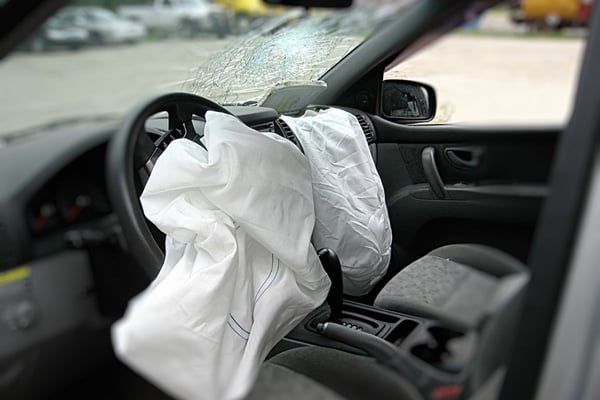Introduction
Imagine yourself cruising along the highway, when suddenly, out of nowhere, a reckless driver barrels into your lane, causing a bone-jarring collision. In that split second, your world is turned upside down. But amidst the chaos, there’s a glimmer of hope: the airbags in your car, deploying like lightning-fast guardians, enveloping you in a protective embrace. Airbags have become an indispensable safety feature in modern vehicles, safeguarding countless lives and mitigating the severity of car accidents. They’re like invisible lifelines, ready to spring into action when danger strikes, providing a crucial buffer between you and potential harm.
How Airbags Work
Airbags are ingenious devices, designed to inflate in a matter of milliseconds upon impact. They’re tucked away discreetly within the steering wheel, dashboard, and side panels of your car, waiting patiently for their moment to shine. When a sudden deceleration occurs, such as in a collision, sensors detect the change in force and trigger the airbag deployment system. A chemical reaction takes place, rapidly releasing nitrogen gas into the airbag, causing it to inflate with explosive speed. Within a fraction of a second, the airbag expands to its full size, providing a soft, protective cushion between you and the hard interior surfaces of your car. This cushioning effect helps to absorb the impact of the collision, reducing the risk of serious injuries.
Types of Airbags
Airbags come in various types, each designed to protect different areas of the body. Front airbags, the most common type, deploy from the steering wheel and dashboard to safeguard the driver and front-seat passenger. Side airbags, located in the doors or seats, provide protection from side-impact collisions. Curtain airbags, mounted along the roofline, extend downwards to shield occupants from rollovers or side impacts. Knee airbags, found beneath the dashboard, offer additional protection for the driver’s legs. Some vehicles even feature center airbags, which deploy from the center console to prevent occupants from colliding with each other during a crash.
Effectiveness of Airbags
Studies have consistently demonstrated the effectiveness of airbags in reducing the risk and severity of car accident injuries. According to the National Highway Traffic Safety Administration (NHTSA), airbags have saved over 50,000 lives in the United States since their introduction in the 1980s. Airbags have been particularly effective in preventing fatalities and serious injuries in frontal and side-impact collisions. They work synergistically with seatbelts to provide a comprehensive safety system, significantly reducing the likelihood of head, chest, and abdominal injuries.
Conclusion
Airbags are a testament to the relentless pursuit of safety in the automotive industry. They’re like guardian angels, standing ready to protect you and your loved ones in the event of a car accident. While no safety feature can completely eliminate the risks associated with driving, airbags provide a crucial layer of protection, giving you peace of mind and increasing your chances of emerging from a collision with minimal harm.
Car Accident Airbags: A Lifesaving Technology
Remember when car accidents were a lot more fatal than they are today? Well, you can thank airbags for that. Airbags are life-saving devices that have saved countless lives and prevented serious injuries in car accidents. They are designed to inflate rapidly in the event of a collision, providing a cushion between the occupant and the hard interior of the vehicle.
Types of Airbags
There are various types of airbags, including frontal, side, curtain, knee, and rear-seat airbags, each designed to protect specific parts of the body:
Frontal Airbags
Frontal airbags are the most common type of airbag. They are located in the dashboard and steering wheel and deploy in the event of a head-on collision. Frontal airbags are designed to protect the driver and front-seat passenger from serious head and chest injuries.
Side Airbags
Side airbags are located in the side panels of the vehicle and deploy in the event of a side-impact collision. Side airbags are designed to protect the occupants from serious head, chest, and abdominal injuries.
Curtain Airbags
Curtain airbags are located along the roof of the vehicle and deploy in the event of a rollover or side-impact collision. Curtain airbags are designed to protect the occupants from serious head and neck injuries.
Knee Airbags
Knee airbags are located below the dashboard and deploy in the event of a frontal collision. Knee airbags are designed to protect the driver’s knees from serious injuries.
Rear-Seat Airbags
Rear-seat airbags are located in the rear of the vehicle and deploy in the event of a rear-end collision. Rear-seat airbags are designed to protect the rear-seat passengers from serious head and neck injuries.
Car Accident Airbags: What You Need to Know
Airbags have become an indispensable safety feature in modern vehicles, providing a crucial layer of protection in the event of a collision. These inflatable cushions have saved countless lives and reduced the severity of countless other injuries.
How Airbags Work
Airbags operate on a complex system that involves crash sensors, an inflator, and a rapidly expanding cushion. When a collision occurs, impact sensors placed throughout the vehicle send signals to the airbag control unit. The unit then triggers the inflator, which releases a burst of compressed nitrogen gas into the airbag. The airbag rapidly expands, filling the space between the occupant and the hard interior surfaces of the vehicle, providing a soft cushion that helps to absorb the force of the impact.
Types of Airbags
There are various types of airbags designed to protect different areas of the body, including:
- Front airbags: Located in the dashboard or steering wheel to protect the driver and front passenger’s heads and chests.
- Side airbags: Positioned in the seats or doors to safeguard occupants from side impacts.
- Knee airbags: Situated below the dashboard to minimize leg and knee injuries.
- Curtain airbags: Mounted along the roofline to provide head protection in side-impact or rollover accidents.
Advantages of Airbags
Airbags offer numerous advantages, including:
- Reduced risk of head and chest injuries: Airbags cushion the head and chest during a collision, minimizing the likelihood of severe injuries such as skull fractures, traumatic brain injuries, and internal bleeding.
- Increased occupant stability: Airbags provide lateral support, preventing occupants from being thrown about the vehicle during a crash.
- Compatibility with seatbelts: Airbags work in conjunction with seatbelts to maximize occupant safety. They are designed to supplement the protection provided by seatbelts, not replace them.
Limitations of Airbags
While airbags offer significant safety benefits, it’s important to note their limitations:
- Can cause injuries in certain circumstances: Improperly deployed airbags can cause injuries, particularly to children and elderly occupants. Airbags can deploy with great force, potentially causing burns, eye injuries, or even broken bones.
- Not effective in all types of crashes: Airbags are designed to protect occupants in frontal and side-impact collisions but may not be effective in other types of crashes, such as rollovers or rear-end collisions.
- May interfere with proper vehicle operation: Airbag deployment can obscure the driver’s view and interfere with steering and braking. It’s crucial to follow proper safety precautions and allow time for the airbag to deflate before driving.
Car Accident Airbags: A Lifeline in the Face of Danger
In the high-stakes game of road safety, airbags have emerged as a life-saving mechanism that helps turn potentially fatal accidents into survivable ones. These inflatable cushions are strategically placed within vehicles to protect occupants from the violent impact forces of a collision.
The Effectiveness of Airbags
Airbags have proven their mettle in drastically reducing the risk of severe injuries and fatalities. They work by rapidly inflating upon impact, absorbing the energy of the collision and preventing occupants from being thrown against hard interior surfaces or ejected from the vehicle. Crash test data has consistently shown that airbags significantly lower the likelihood of head, neck, and chest injuries, often reducing the severity of these injuries by half or more.
Deployment and Technology
Airbags are deployed in milliseconds using a series of sensors and chemical reactions. When a collision occurs, sensors detect the sudden deceleration of the vehicle and trigger the release of compressed gas. This gas inflates the airbags within fractions of a second, creating a protective buffer between occupants and the vehicle’s interior. Modern airbags are designed to adapt to different crash scenarios, varying their inflation speed and firmness based on the severity of the impact.
Proper Use and Limitations
To maximize the effectiveness of airbags, it’s crucial to wear seatbelts and maintain a safe distance from the steering wheel and dashboard. Failure to do so can increase the risk of injury from airbag deployment. While airbags are incredibly effective, they have limitations. They are not designed to prevent all injuries, and they can be ineffective in certain types of collisions, such as side-impact crashes.
Ongoing Innovations
The field of airbag technology is constantly evolving, with researchers striving to improve deployment speed, reduce the risk of occupant injuries, and extend protection to all parts of the vehicle. Some promising advancements include adaptive airbags that adjust their inflation to the size and position of the occupant, as well as external airbags that deploy outside the vehicle to protect pedestrians and cyclists. As technology progresses, airbags will continue to play a vital role in enhancing road safety and protecting lives.
Car Accident Airbags: A Vital Safety Feature with Potential Risks
In the event of a car accident, airbags deploy with astonishing speed, inflating within milliseconds to provide a crucial buffer between occupants and the vehicle’s interior. While these life-saving devices have dramatically reduced fatalities and serious injuries, they are not without their potential hazards.
How Airbags Work
Airbags are triggered by sensors that detect a sudden deceleration or impact. These sensors send a signal to an electronic control unit, which then ignites a chemical reaction that produces nitrogen gas. The rapidly expanding gas fills the airbag, which unfolds and expands within a fraction of a second.
Benefits of Airbags
Airbags provide a number of benefits in a car accident. They:
- Slow down the forward momentum of occupants, reducing the risk of head, neck, and chest injuries.
- Deploy in a matter of milliseconds, providing protection before the body can impact the interior.
- Are designed to work in conjunction with seat belts, maximizing their effectiveness.
Potential Hazards
While airbags are generally safe, there are potential hazards, such as the risk of airbag-related injuries, especially for children and occupants who are not properly positioned or wearing seat belts.
Risk of Airbag-Related Injuries
Airbags deploy with great force, and this sudden inflation can cause injuries, particularly to the face and neck. Common injuries include:
- Facial cuts and lacerations
- Neck strains and sprains
- Eye injuries, such as corneal abrasions
- Rarely, more severe injuries, such as fractures or concussions
Children, the elderly, and occupants who are not properly positioned or wearing seat belts are at the highest risk of airbag-related injuries. Airbags are designed to inflate in front of occupants, so if they are not seated properly or are leaning forward, they may be struck by the airbag. Similarly, seat belts help to keep occupants in position, reducing the likelihood of being thrown into the airbag.
To minimize the risk of airbag-related injuries, always wear your seat belt, ensure that children are properly restrained in child seats or booster seats, and avoid leaning forward or placing objects on the dashboard.
Car Accident Airbags: A Lifeline in Perilous Moments
Car accidents are, unfortunately, an all-too-common occurrence on our roads today. When a collision strikes, airbags can often be the difference between life and death, or serious injury and minor bumps and bruises. But how do these devices work, and what are the legal requirements and standards that govern their use?
How Airbags Work
Airbags are inflatable cushions that deploy from the dashboard or steering wheel in the event of a collision. They are designed to catch and cradle passengers, preventing them from hitting hard surfaces such as the windshield or dashboard. Airbags inflate in a fraction of a second, providing a vital layer of protection.
Legal Requirements and Standards
Given their life-saving potential, airbags are mandated in most countries. These devices must meet rigorous safety standards, including:
- Deployment time: Airbags must inflate within a certain amount of time after a collision.
- Inflating force: The force of the airbag’s inflation should not cause additional injuries.
- Durability: Airbags must be able to withstand the force of a collision and not rupture.
- Compatibility: Airbags must be compatible with the vehicle’s seat belt system.
- Placement: Airbags should be placed in areas where they can provide the most protection to passengers.
- Indicators: Airbags should be equipped with indicators that show when they are active and when they have deployed.
Types of Airbags
There are several different types of airbags, including:
- Frontal airbags: These airbags deploy from the dashboard and protect the driver and front-seat passenger.
- Side airbags: These airbags deploy from the side of the vehicle and protect occupants from impacts from the side.
- Curtain airbags: These airbags deploy from the ceiling and protect occupants from impacts from above.
- Knee airbags: These airbags deploy from the lower dashboard and protect the driver’s knees.
Airbag Safety
While airbags are essential safety devices, they can also pose risks. Here are some safety tips to keep in mind:
- Always wear your seatbelt. Airbags work best when combined with seat belts.
- Position airbags correctly. Airbags should be placed according to the manufacturer’s instructions.
- Maintain your airbags. Airbags should be inspected regularly and replaced if necessary.
Conclusion
Airbags are a vital safety feature in modern vehicles. By understanding their function, legal requirements, and safety precautions, we can maximize their effectiveness and reduce the risks associated with car accidents.
Airbags: A Lifeline in Car Accidents
Imagine driving down the road, minding your own business, when suddenly, a reckless driver plows into your car. In that split second, the airbags deploy, inflating like giant pillows to protect you from the impact. Airbags have saved countless lives and prevented countless serious injuries, and they continue to evolve to become even more effective.
Advancements in Airbag Technology
Ongoing research and advancements in airbag technology aim to enhance their effectiveness, reduce potential hazards, and adapt to evolving vehicle designs and safety needs. Here are some of the most promising developments:
- Smaller and more compact airbags: Traditional airbags can be bulky and take up valuable space in the cabin. Newer airbags are being designed to be smaller and more compact, allowing for more legroom and storage space.
- Multi-stage airbags: These airbags inflate in two or more stages, depending on the severity of the impact. This allows for more precise protection, as the airbags can be tailored to the specific needs of each occupant.
- Pedestrian airbags: These airbags deploy from the outside of the vehicle to protect pedestrians in the event of a collision. This is a relatively new technology, but it has the potential to save lives and prevent serious injuries.
- Side impact airbags: These airbags deploy from the sides of the vehicle to protect occupants from side-impact collisions. Side-impact airbags are becoming increasingly common, as they can provide significant protection in a variety of crashes.
- Curtain airbags: These airbags deploy from the roof of the vehicle to protect occupants from rollovers and other types of roof-related injuries. Curtain airbags are also becoming more common, as they offer a high level of protection in a variety of rollover scenarios.
- Smart airbags: These airbags use sensors to determine the size, weight, and position of the occupant before they deploy. This allows the airbags to be tailored to the specific needs of each occupant, providing optimal protection.
These are just a few of the advancements that are being made in airbag technology. As research continues, we can expect to see even more innovative and effective airbags in the future.





Leave a Reply